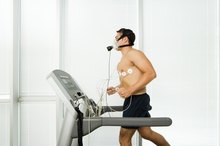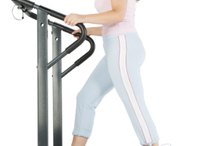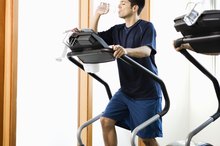More Articles
What Happens During Exercise at 90% of Maximum Heart Rate?
When exercising at 90 percent of your maximum heart rate, your breathing will be very rapid as your cardiovascular system works strenuously to provide enough oxygen and energy to your working muscles. Only the best-conditioned athletes are able to exercise at this level for very long. According to experts at Rice University, most people exercising this hard will have difficulty getting enough oxygen to their contracting muscles, and as a result, your muscles will switch from using oxygen to burn energy (aerobic) to burning energy without oxygen (anaerobic).
Sprinting Versus Jogging
While jogging, most people are burning energy aerobically and anaerobically. At this pace, the body is able to remove the lactic acid that is produced by the anaerobic process. But as the pace quickens, more lactic acid is produced, and eventually the accumulation of lactic acid in the bloodstream becomes so great that the muscles start burning, and eventually the exercise has to stop. That point is known as the anaerobic threshold (AT), and for many people, the AT occurs somewhere near 90 percent of your maximum heart rate.
- While jogging, most people are burning energy aerobically and anaerobically.
- That point is known as the anaerobic threshold (AT), and for many people, the AT occurs somewhere near 90 percent of your maximum heart rate.
Calculating Your Maximum Heart Rate
Lack of Oxygen During Running
Learn More
You can estimate your maximum heart rate, or MHR, by subtracting your age from 220. But Greg Crowther, a research scientist at the University of Washington, says the only precise way to find your MHR is through a stress test. You can do this test yourself by running laps on a 400-meter track wearing a heart rate monitor. After two comfortable laps, increase your pace by four seconds per lap. Your heart rate will climb as you run faster, and as you near exhaustion, you will notice your heart rate leveling off. That point is your MHR.
- You can estimate your maximum heart rate, or MHR, by subtracting your age from 220.
Reaching the Anaerobic Threshold
The anaerobic threshold, that point where your muscles are producing more lactic acid than your body can remove, varies from person to person. Highly trained athletes may not reach their AT until they are very close to their MHR. Sedentary individuals can reach that point at 70 percent of their MHR, Rice researchers say.
Raising the Anaerobic Threshold
How to Calculate VO2 Reserve
Learn More
You can train your body to remove lactic acid at higher and higher levels of intensity. According to Rice researchers, training with a series of short, high-intensity bursts followed by a period of rest or - more appropriately - active rest (walk, slow jog) will stimulate enzymes in the mitochondria of your working muscles and allow you to raise your anaerobic threshold. Accordingly, improved conditioning is one reason to train at this level for short periods. Sprints, for example, have been recently touted for their various benefits.
- You can train your body to remove lactic acid at higher and higher levels of intensity.
- According to Rice researchers, training with a series of short, high-intensity bursts followed by a period of rest or - more appropriately - active rest (walk, slow jog) will stimulate enzymes in the mitochondria of your working muscles and allow you to raise your anaerobic threshold.
What's the Best Combination?
According to Dr. Len Kravitz of the University of New Mexico, research shows that training programs that combine a lot of low-intensity aerobic training with these high-intensity interval workouts "have the most pronounced effect on lactate threshold improvement." Never increase your training volume for either intensity by more than 10 percent a week, Kravitz says 2. Your high-intensity workouts should never be more than 10 percent of your total training volume--if you run 30 miles a week, never do more than 3 miles of that distance at your lactate threshold.
- According to Dr. Len Kravitz of the University of New Mexico, research shows that training programs that combine a lot of low-intensity aerobic training with these high-intensity interval workouts "have the most pronounced effect on lactate threshold improvement.
- " Your high-intensity workouts should never be more than 10 percent of your total training volume--if you run 30 miles a week, never do more than 3 miles of that distance at your lactate threshold.
Related Articles
References
- Greg Crowther: Training and Racing With a Heart Monitor
- Dr. Len Kravitz and Lance Dalleck, Ph.D.: Lactate Threshold Training
- Comana F. The lactic acid lowdown: Clarifying common misconceptions. National Academy of Sports Medicine, June 2016.
- Lewis PB, Ruby D, Bush-Joseph CA. Muscle soreness and delayed-onset muscle soreness. Clin Sports Med. 2012;(31)2:255-62. doi:10.1016/j.csm.2011.09.009
- Todd, JJ. Lactate: Valuable for physical performance and maintenance of brain function during exercise. Bioscience Horizons. 2014;(7):1-7. doi:10.1093/biohorizons/hzu001
- Nalbandian M, Takeda M. Lactate as a signaling molecule that regulates exercise-induced adaptations. Biology (Basel). 2016;(5)4. doi:10.3390/biology5040038
- Friel J. Fast After 50: How to Race Strong for the Rest of Your Life. Velopress, 2015.
- Tupling R. Lactic acid accumulation is an advantage/disadvantage during muscle activity. J Appl Physiol. 2006;100(6):2101-2. doi:10.1152/japplphysiol.00213.2006
Writer Bio
Jim Sloan is a writer and editor in Reno, Nevada. He has been a journalist for more than 25 years and is the author of two books, "Staying Fit After Fifty," and "Nevada: True Tales from the Neon Wilderness."









